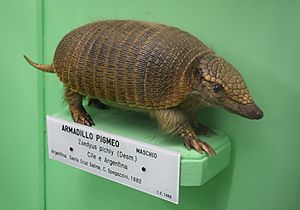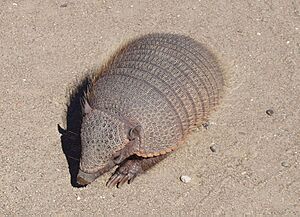Pichi facts for kids
Quick facts for kids Pichi |
|
|---|---|
 |
|
| Conservation status | |
| Scientific classification | |
| Genus: |
Zaedyus
|
| Species: |
pichiy
|
 |
|
| Range of Zaedyus pichiy | |
| Synonyms | |
|
Dasypus minutus Desmarest, 1822 |
|
The pichi (Zaedyus pichiy) is a small armadillo that lives in Argentina. It's also called the dwarf armadillo or pygmy armadillo. It's special because it's the only living member of its group, Zaedyus, and the only armadillo known to hibernate (sleep through winter).
Contents
About the Pichi Armadillo

Pichis are quite small armadillos. They are about 27 centimeters (11 inches) long, with a tail that adds another 11 centimeters (4 inches). Adult pichis usually weigh between 700 and 1500 grams (1.5 to 3.3 pounds). Males might be a little bigger than females.
Their shell, called a carapace, can be light yellow to almost black. It's made of tough, rectangular plates called osteoderms. These plates form strong shields on their shoulders and hips, with six to eight movable bands in the middle. They also have a shield on their head and more plates along their tail.
The pichi's belly is covered in tan-colored hair. This fur gets thicker and longer in winter to keep them warm. They have strong claws on all four feet, which are great for digging. Their ears are short, and their eyes are dark and small.
Where Pichis Live
Pichis are found in central and southern Argentina, especially in a region called Patagonia. They also live west in the Andean grasslands of Chile, all the way down to the Strait of Magellan.
They mostly prefer dry or semi-dry grasslands. However, you might find them in other places if the soil is sandy and easy for them to dig burrows in.
Pichi Subspecies
There are two main types, or subspecies, of pichis:
- Zaedyus pichiy caurinus
- Zaedyus pichiy pichiy
Pichi Diet and Life Cycle
Pichis are omnivores, meaning they eat both plants and animals. Most of their diet is made up of small creatures like beetles, ants, and scorpions. They also eat small mammals or lizards, as well as plants and fungi. Even though they live in dry places, they don't seem to need to drink water in the wild.
Some animals that hunt pichis include crowned eagles, buzzard-eagles, foxes, and cougars.
Pichis are the only armadillos known to hibernate. Before winter, they eat a lot to build up fat. They stay in their burrows from May to August, sleeping through the coldest months. During this time, their body temperature drops from about 35°C (95°F) to just 14°C (57°F). They also have daily periods of torpor (a short, deep sleep) each night, where their temperature can drop to 24°C (75°F).
The breeding season for pichis is from spring to early summer. Females usually have one or two babies after being pregnant for about 58 to 60 days. This typically happens between October and January. Newborn pichis have soft, pink skin with tiny plates that harden and turn yellow after about two weeks. They weigh around 50 grams (1.8 ounces) at birth and grow quickly, gaining about 9 grams (0.3 ounces) each day until they stop drinking milk at about 40 days old. That's when they leave their burrow for the first time!
Pichi Behavior

Pichis are usually solitary animals, meaning they live alone. They are also diurnal, which means they are active during the day. They dig burrows in sandy soil to protect themselves from bad weather.
Their burrows have a round entrance and a single tunnel that can be several meters long. It ends in a simple resting room without any lining. Pichis don't stay in the same burrow for long; they often dig new ones every few weeks, or even every day! In winter, when the weather is harsher, their burrows can be deeper, sometimes reaching 1.5 meters (5 feet) underground.
When a pichi feels threatened, it might wedge itself into its shallow burrow. This makes it hard for an attacker to pull it out because of its rough scales. They can also lie flat on the ground to protect their soft belly. People have heard pichis make purring sounds, as well as loud grunts or screams when they are scared.
Conservation Status
The IUCN (International Union for Conservation of Nature) says that the pichi is a near-threatened species. This means it could become endangered in the future if we don't protect it.
People sometimes hunt pichis for food or for sport, even though they are protected in Argentina. Their meat is eaten, and their shells are used to make local crafts. Another big threat to pichis is cattle ranching, which destroys their natural habitat. Some pichi groups have also been affected by a mysterious disease.
See also
 In Spanish: Piche para niños
In Spanish: Piche para niños



